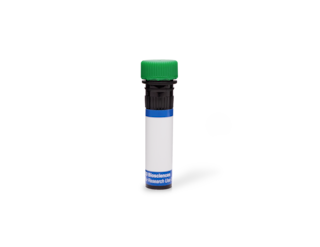-
Reagents
- Flow Cytometry Reagents
-
Western Blotting and Molecular Reagents
- Immunoassay Reagents
-
Single-Cell Multiomics Reagents
- BD® OMICS-Guard Sample Preservation Buffer
- BD® AbSeq Assay
- BD® Single-Cell Multiplexing Kit
- BD Rhapsody™ ATAC-Seq Assays
- BD Rhapsody™ Whole Transcriptome Analysis (WTA) Amplification Kit
- BD Rhapsody™ TCR/BCR Next Multiomic Assays
- BD Rhapsody™ Targeted mRNA Kits
- BD Rhapsody™ Accessory Kits
- BD® OMICS-One Protein Panels
- BD OMICS-One™ WTA Next Assay
-
Functional Assays
-
Microscopy and Imaging Reagents
-
Cell Preparation and Separation Reagents
Old Browser
This page has been recently translated and is available in French now.
Looks like you're visiting us from {countryName}.
Would you like to stay on the current location site or be switched to your location?
BD Transduction Laboratories™ Purified Mouse Anti-HIF-1β/ARNT1
Clone 29/HIF-1b (RUO)





Western blot analysis of HIF-1β on Jurkat cell lysate. Lane 1: 1:1000, lane 2: 1:2000, lane 3: 1:4000 dilution of the Mouse Anti- HIF-1β antibody.

Immunofluorescent staining of A431 cells.




Regulatory Status Legend
Any use of products other than the permitted use without the express written authorization of Becton, Dickinson and Company is strictly prohibited.
Preparation And Storage
Product Notices
- Since applications vary, each investigator should titrate the reagent to obtain optimal results.
- Source of all serum proteins is from USDA inspected abattoirs located in the United States.
- Caution: Sodium azide yields highly toxic hydrazoic acid under acidic conditions. Dilute azide compounds in running water before discarding to avoid accumulation of potentially explosive deposits in plumbing.
- Please refer to www.bdbiosciences.com/us/s/resources for technical protocols.
Companion Products



The Ah-receptor (AHR) is a ligand activated transcription factor that mediates the biological effects of agonists. AHR dimerizes with a structurally related protein known as ARNT (arylhydrocarbon-receptor nuclear transducer). This heterodimer binds enhancer elements and induces the expression of target genes, specifically those involved in the metabolism of xenobiotics. ARNT1 and ARNT2 are members of the basic-helix-loop-helix-PAS family of heterodimeric transcription factors, which also includes AHR, hypoxia-inducible factor-1α (HIF-1α), and the Drosophila single-minded protein (Sim). While ARNT2 expression is limited to brain and kidney, ARNT1 exhibits ubiquitous expression. A targeted disruption of the Arnt locus in the mouse yields embryonic stem cells that fail to activate genes that normally respond to low oxygen tension. Arnt -/- embryos do not survive and show defective angiogenesis of the yolk sac and branchial arches, stunted development, and wasting. Thus, in addition to its regulation of xenobiotic metabolism genes, ARNT is thought to induce developmental gene expression resulting in vascularization of the developing embryo.
Development References (6)
-
Ambrosini G, Nath AK, Sierra-Honigmann MR, Flores-Riveros J. Transcriptional activation of the human leptin gene in response to hypoxia. Involvement of hypoxia-inducible factor 1. J Biol Chem. 2002; 277(37):34601-64609. (Clone-specific: Gel shift, Western blot). View Reference
-
Drutel G, Kathmann M, Heron A, Schwartz JC, Arrang JM. Cloning and selective expression in brain and kidney of ARNT2 homologous to the Ah receptor nuclear translocator (ARNT). Biochem Biophys Res Commun. 1996; 225(2):333-339. (Biology). View Reference
-
Fallone F, Britton S, Nieto L, Salles B, Muller C. ATR controls cellular adaptation to hypoxia through positive regulation of hypoxia-inducible factor 1 (HIF-1) expression. Oncogene. 2013; 32(37):4387-4396. (Clone-specific: Western blot). View Reference
-
Jiang BH, Jiang G, Zheng JZ, Lu Z, Hunter T, Vogt PK. Phosphatidylinositol 3-kinase signaling controls levels of hypoxia-inducible factor 1. Cell Growth Differ. 2001; 12(7):363-369. (Clone-specific: Western blot). View Reference
-
Maltepe E, Schmidt JV, Baunoch D, Bradfield CA, Simon MC. Abnormal angiogenesis and responses to glucose and oxygen deprivation in mice lacking the protein ARNT. Nature. 1997; 386(6623):403-407. (Biology). View Reference
-
Suzuki H, Tomida A, Tsuruo T. Dephosphorylated hypoxia-inducible factor 1alpha as a mediator of p53-dependent apoptosis during hypoxia. Oncogene. 2001; 20(41):5779-5788. (Clone-specific: Immunoprecipitation, Western blot). View Reference
Please refer to Support Documents for Quality Certificates
Global - Refer to manufacturer's instructions for use and related User Manuals and Technical data sheets before using this products as described
Comparisons, where applicable, are made against older BD Technology, manual methods or are general performance claims. Comparisons are not made against non-BD technologies, unless otherwise noted.
For Research Use Only. Not for use in diagnostic or therapeutic procedures.